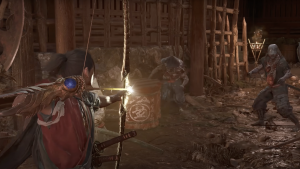Jake Sully bonding with his dragon-like Ikran and soaring across the skies of Pandora is one of the most iconic scenes from 2009’s Avatar. Ubisoft and Massive Entertainment’s new video game, Avatar: Frontiers of Pandora, lets players tame their own Ikran first-hand, but there’s an undercurrent to the game’s depiction of this Na’vi rite of passage that profoundly sets it apart from the movie.
“This scene is very much reflective of my own experience as a mixed-race Black person,” explains the game’s senior narrative designer, Chella Ramanan. “When the player attempts to bond with its Ikran, it begs the question, ‘Am I Na’vi enough to do this? What if I get rejected?’ It’s about an internal identity crisis.”
The game puts players in control of a Na’vi who, as a child, was plucked from their tribe by the RDA, bred to be a loyal soldier, and then plunged into a cryosleep only to awaken 15 years later, free to rediscover their Na’vi roots. But not all Na’vi are prepared to trust or welcome this outsider back, which raises unusual, at least for a video game, questions explored throughout the experience.
Ramanan’s storytelling in Avatar: Frontiers of Pandora reflects the kind of work she’s dedicated her career to. A former games journalist, she is also the founder of POC in Play, an independent organization committed to increasing representation in games and amplifying the voices of people of color within the industry. The game’s Ikran scene is the kind of real-world-inspired storytelling Ramanan has worked hard to propagate for so long.
“I really identify with the sense of not being enough of one thing or too much of another,” she says. “You have to wrestle with who you are and who society thinks you are. I tried to draw from this struggle in my approach to telling the game’s story. We wanted to make the player feel like they belong to Pandora, that they are Na’vi enough.”
At its heart, the Avatar story is about the power of empathy. But it’s also about the importance of environmentalism, characterized by the Na’vi’s fight to protect Pandora from the invading forces of the RDA. Associate game designer Drew Rechner says that the team’s primary goal was to make Pandora a hero in itself.
“One of the coolest opportunities in making this game was taking the amazing world, cultures, plants, and animals from the films and incorporating them into game mechanics that are fun and stay true to the ethos of Avatar,” Rechner says.
The developers wanted to establish a strong connection between the player and the game world. This is why, for example, the game features a minimalist HUD so that there is less onscreen information to distract the player from soaking up the sights and sounds of the environments around them. After playing a two-and-a-half-hour preview demo of the game, we can confirm the game’s sound design, in particular, is stellar.
“It would be a shame if the player were blindly following UI markers constantly,” Rechner explains. “We really want the players to take in the world without being distracted.”
Crafting a deeply immersive Avatar experience meant the developers had to make exploring Pandora engaging in its own right, which led to some extensive tweaking of the game’s main modes of traversal: on-foot movement and Ikran flight. The team dialed in the camera transitions between running, jumping, and climbing over ledges to make movement as smooth and fun to control as possible. As for the Ikran flight, that was a different problem to solve entirely.
“With the Ikran flight, one of the things we wanted to do was give the player a new perspective of Pandora,” Rechner explains. “You start the game beneath the canopy of the forest, so you can’t really see very far in the distance. But when you get on your banshee and fly above the canopy, it gives you a whole new view of the world. We made sure that the speed of flight didn’t feel too limiting, and we made sure that every location the player sees is accessible via the Ikran. You see floating mountains at the beginning of the game, and when you eventually unlock your Ikran, you can fly to those mountains, and it feels really cool.”
Many of the game’s mechanics are based on interacting with and learning about Pandora, from carefully picking fruit off of the vine to preserve the quality of the produce to approaching wounded animals carefully to earn their trust. “We wanted the gameplay to focus on the player becoming Na’vi, which is really about connecting with nature,” Rechner explains. “Your character’s power literally comes from Pandora.”
The Western Frontier’s three regions are distinctive, but their differences run deeper than aesthetics alone. The Kinglor Forest resembles the locales from the films and acts as a familiar environment to introduce players to the basics of the gameplay; the wide open spaces and long sight lines of the Upper Plains encourage sniper-based combat, and the thick vegetation of the Clouded Forest provides ample opportunity for stealth takedowns. “With each region, we really tried to lean into what the environments provided to us gameplay-wise,” Rechner explains. “That keeps things fresh and interesting as you progress through the game.”
To ensure every element of gameplay and story made sense within the Avatar universe, Massive worked closely with James Cameron’s Lightstorm Entertainment. The team would present Lightstorm with gameplay ideas, and Lightstorm would help align them with the ethos of the films, whether it be leaning into the asymmetrical nature of Na’vi and RDA combat or assuring the various biomes across the map made sense within Pandora’s overall climate.
“Lightstorm are the moviemaking experts and we’re the people who make video games—there was a great respect for each other’s expertise,” Rechner says. “They know everything about the films and are currently working on them, so they were the best partners to have. There is actually a lot of science and biology that goes into Lightstorm’s creative process and we picked up on that expertise over the course of our partnership.”
Ramanan and the narrative team had a constant back-and-forth with Lightstorm as well, using their knowledge to help create the game’s cast of characters. “We were able to create entirely new Na’vi clans and all of the characters within each clan,” she says. “It’s been really rewarding writing all of the backstories for our named characters. All of them have unique perspectives, they have relationships with each other and we know how they all fit together. We wrote them to feel like authentic people who are living rich lives even when you’re not standing in front of them.”
Before the team wrote even one line of dialogue, they sat down and mapped out the main cast of characters and defined each of their personalities and relationships with one another. The goal was to craft characters that felt fully fleshed out and authentic and would react to the world and each other in the way real people, in all their complexity, would.
“The wants and needs that these characters project to the world are very different from what they actually want and need internally,” Ramanan explains. “Each clan is different and has differing responses to the RDA, and the characters within each clan have unique conflicts amongst themselves. They often don’t agree on how to deal with issues and threats. We worked really hard on the nuance of each character’s behaviors and values.”
The family dynamic between Ka’nat, the leader of the Aranahe clan, and his strong-willed daughter Etuwa is a prime example of the game’s emphasis on complex characters. They love each other, and both want what’s best for their tribe, but their differing views on conflict resolution and tradition drive a wedge between them that leads to an act of defiance. The clans aren’t monolithic, and they all have internal conflicts in addition to the external fight against the RDA.
Perhaps most vital to the game was the decision to present it from a first-person perspective. Not only does it allow players to explore and interact with Pandora and its exotic wildlife up close, but it also feeds into the true power of video games as a sort of empathy machine that puts you in the shoes of someone else.
“Video games reach huge audiences and I consider them to be the modern storytelling medium,” Ramanan says. “First-person gameplay makes things feel a lot more tactile and intimate, and only video games can do that because the player has agency in the game world, which helps them identify with the story and the experience. When you’re leaping off a cliff and getting caught by your Ikran, you feel that sense of liberation along with the character.”
All of the attention to detail, the extensive tweaking of gameplay, the hours of writing meetings to get the dialogue just right were all in service of making a game worthy of the Avatar legacy. For Ramanan, Rechner, and all of Massive, staying true to the elements that made the movies so beloved while pushing themselves to create a unique experience that stands on its own was a worthwhile labor of love.
“I hope that the journey from being unsure about what it means to be Na’vi to gaining a sense of belonging in Pandora resonates with players,” Ramanan says. “We poured a lot of love into the characters you meet in the game, and I hope players feel as passionately for their story as we do.”
Avatar: Frontiers of Pandora is out on Dec. 7 for Xbox Series X/S, PlayStation 5, and PC.
The post How Frontiers of Pandora Honors and Evolves Avatar’s Legacy appeared first on Den of Geek.










